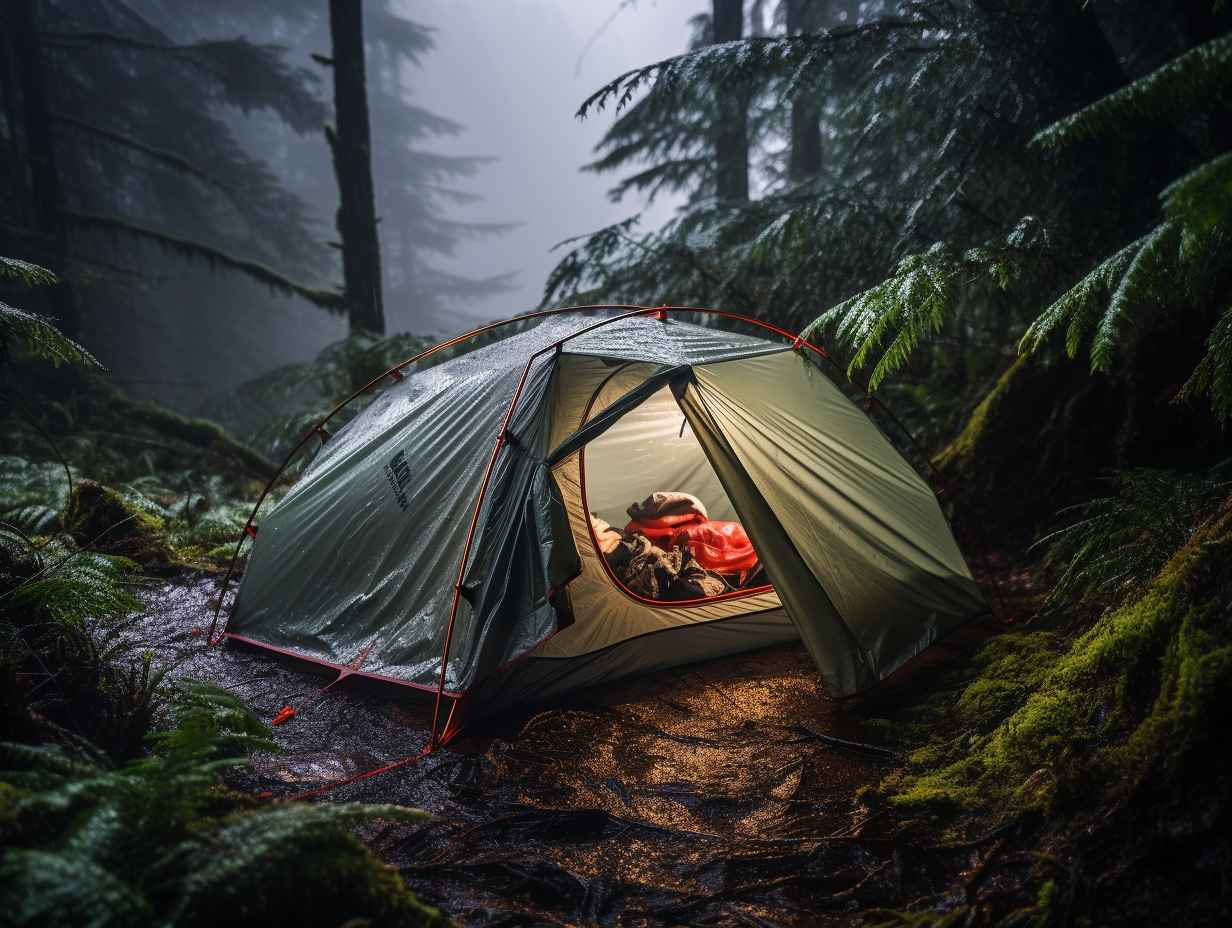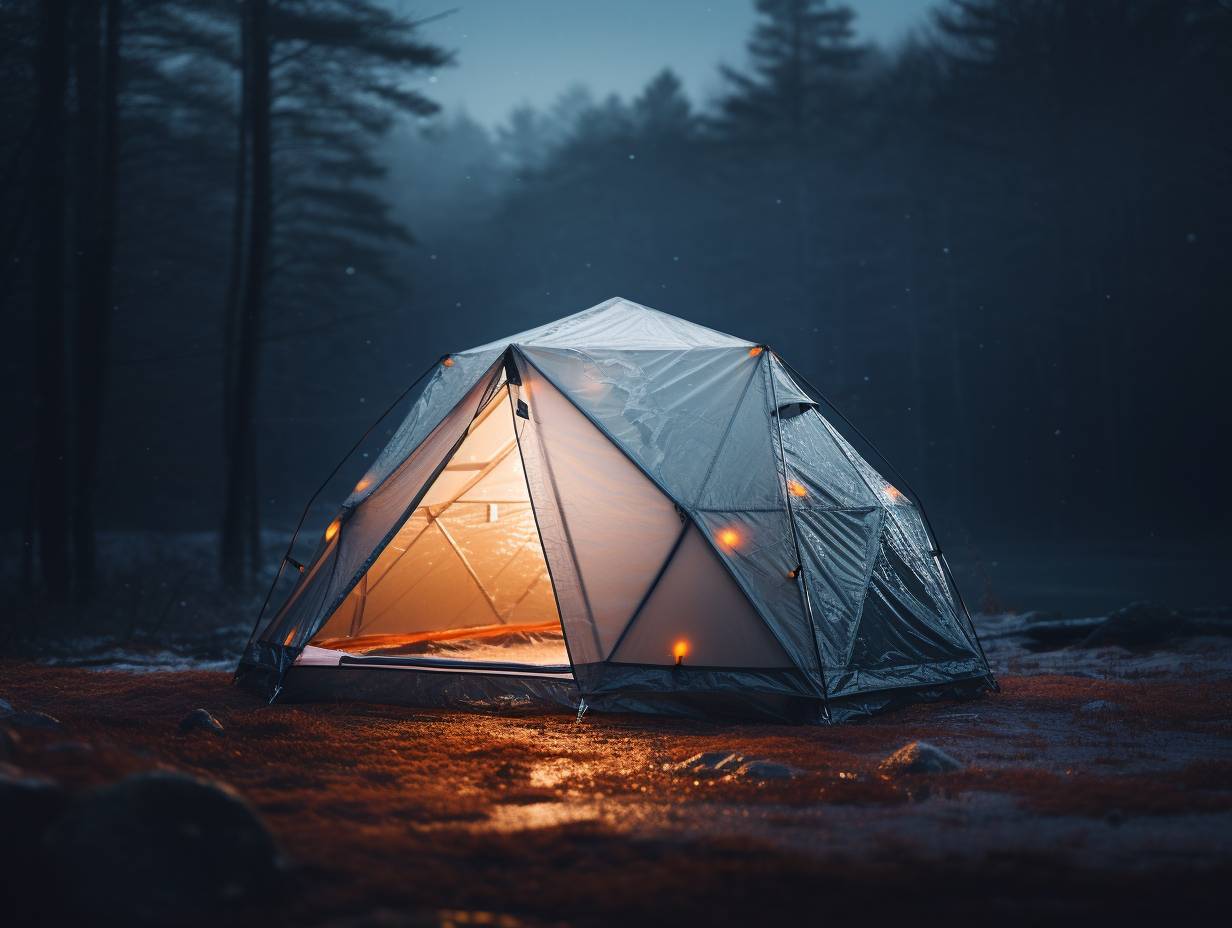
Are Camping Tents Waterproof
Table Of Contents
- Key Takeaways
- Tent Materials: Understanding the Waterproofing Properties
- Seam Sealing: Importance and Techniques
- Rainfly: How It Enhances Waterproofing
- Tent Design: Factors That Affect Waterproof Performance
- Tent Care and Maintenance: Ensuring Long-Term Waterproofing
- Frequently Asked Questions
- Conclusion

Imagine yourself in the middle of a downpour, seeking refuge in a tent that you thought was your trusty shelter. But as the rain relentlessly beats against the fabric, you start to feel dampness seeping through, slowly infiltrating your sanctuary.
You may find yourself wondering, are camping tents truly waterproof? Well, fear not, for in this discussion, we will explore the various factors that determine a tent’s waterproofing capabilities.
From the materials used to the techniques employed, and even the design elements that enhance performance, we will uncover the secrets behind keeping dry in the great outdoors.
So, let’s embark on this journey together and discover if your camping tent can truly withstand the elements.
Key Takeaways
- Most tents are made from nylon or polyester and can be treated with a waterproof coating.
- Seam sealing is essential to prevent water leakage and can be done with seam sealer or seam tape.
- A rainfly provides an extra layer of protection against rain and moisture, reducing condensation inside the tent.
- Tent design factors, such as shape, materials, seams, and frame, can affect waterproof performance.
Tent Materials: Understanding the Waterproofing Properties
Do you know how waterproofing properties of tent materials work? When it comes to camping, it’s essential to have a tent that can keep you dry during unexpected rain showers. The key to a waterproof tent lies in the materials used to construct it. Tent fabric plays a crucial role in determining its waterproofness. Most tents are made from nylon or polyester, both of which can be treated with a waterproof coating to enhance their water resistance. This coating, often a polyurethane or silicone layer, creates a barrier that prevents water from seeping through the fabric.
To determine the waterproofness of a tent, manufacturers assign them waterproof ratings. These ratings are measured in millimeters and indicate the amount of water pressure the fabric can withstand before it starts to leak. For example, a tent with a rating of 2000mm can withstand a 2000 millimeter column of water before it begins to leak. The higher the waterproof rating, the more water-resistant the tent fabric is.
Understanding the waterproof ratings of tent materials can help you choose the right tent for your camping needs. If you anticipate heavy rain or plan on camping in wet conditions, it’s advisable to opt for a tent with a higher waterproof rating. This way, you can enjoy your camping trip without worrying about getting wet inside your tent.
Seam Sealing: Importance and Techniques
If you want to ensure maximum waterproofing for your tent, it’s important to understand the importance and techniques of seam sealing. Seam sealing is an essential step in protecting your tent from water leakage. The seams of a tent are the areas most susceptible to water penetration, as they’re created by stitching together the fabric panels. Without proper sealing, water can seep through these seams and dampen the interior of your tent.
The importance of seam sealing can’t be overstated. By sealing the seams, you create a watertight barrier that prevents water from entering your tent. This is especially crucial during rainy or wet weather conditions, as even the smallest amount of water can make your camping experience uncomfortable and potentially ruin your gear.
There are several techniques for seam sealing that you can employ. The most common method involves using a seam sealer, which is a liquid or gel-like substance that’s applied to the seams using a brush or applicator. The seam sealer fills in the tiny gaps between the threads, creating a waterproof seal.
Another technique is using seam tape, which is a strip of specialized adhesive tape that’s applied directly over the seams. This tape acts as a barrier, preventing water from seeping through.
Rainfly: How It Enhances Waterproofing

To enhance the waterproofing of your tent, consider using a rainfly. A rainfly is an essential piece of gear that provides an extra layer of protection against rain and moisture. Its benefits are manifold.
Firstly, a rainfly acts as a barrier, preventing rainwater from seeping through the tent fabric. It keeps you and your belongings dry, ensuring a comfortable camping experience even in wet conditions.
Additionally, a rainfly helps to reduce condensation inside the tent by providing ventilation and allowing air to circulate. This is particularly important in humid climates where condensation can accumulate and lead to a damp interior.
Installing a rainfly is a straightforward process. Most tents come with built-in attachment points or loops where the rainfly can be secured. Simply drape the rainfly over the top of the tent, ensuring that it covers the entire roof and extends over the sides. Secure it tightly using the provided straps or cords, making sure it’s taut and properly aligned.
It’s important to note that the rainfly shouldn’t touch the tent fabric, as this can create a pathway for water to enter.
Tent Design: Factors That Affect Waterproof Performance
With the rainfly acting as an extra layer of protection against rain and moisture, the design of your tent plays a crucial role in its overall waterproof performance. The construction of the tent, including its shape, materials, and seams, determines how effectively it can keep water out.
A well-designed tent will have a sturdy frame and a shape that allows rainwater to easily slide off, rather than pooling on top. The materials used in the tent’s construction should be waterproof or at least water-resistant, such as coated nylon or polyester. Additionally, the seams of the tent should be sealed or taped to prevent water from seeping through.
Manufacturers employ various waterproofing techniques to enhance the tent’s ability to repel water. These techniques may include applying a waterproof coating to the fabric, using waterproof zippers, and incorporating a bathtub-style floor design that prevents water from entering through the bottom.
Tent Care and Maintenance: Ensuring Long-Term Waterproofing

Regular care and maintenance of your camping tent is essential to ensure long-term waterproofing. One important aspect of tent care is keeping it clean. Dirt, debris, and stains can compromise the waterproof coating of the tent fabric, making it less effective in repelling water. To clean your tent, start by brushing off any loose dirt or debris. Then, use a mild soap and water solution to gently scrub the surface of the tent. Rinse thoroughly with clean water and allow it to air dry completely before packing it away.
Another factor to consider is preventing condensation inside your tent. Condensation occurs when warm air inside the tent comes into contact with a cooler surface, such as the tent walls or rainfly. To minimize condensation, ensure proper ventilation by opening windows or vents. Additionally, avoid cooking or using fuel-burning appliances inside the tent, as they can generate excess moisture.
If condensation does occur, wipe it away with a towel or cloth to prevent it from dripping onto your gear or sleeping area.
Frequently Asked Questions
Are All Camping Tents Waterproof?
Not all camping tents are waterproof. When choosing a tent, consider the materials used. Look for ones made with waterproof fabric, sealed seams, and a rainfly to keep you dry during rainy camping trips.
Can I Make a Non-Waterproof Tent Waterproof?
You can make a non-waterproof tent waterproof by applying a waterproofing spray or coating. Alternatively, you can use a rainfly or tarp to provide an extra layer of protection against water.
How Often Should I Reapply Waterproofing to My Tent?
You should reapply waterproofing to your tent every year to ensure maximum protection. There are various techniques you can use, such as spray-on solutions or wash-in treatments, to maintain the water resistance of your tent.
What Are the Common Signs of a Leaky Tent?
If you notice signs of water damage, like wet spots or musty smells, your tent may be leaking. Don’t worry though, there are ways to fix a leaky tent, such as applying seam sealant or using a waterproof spray.
Can I Use a Rainfly on Any Type of Tent to Enhance Waterproofing?
Using a rainfly can enhance waterproofing for any type of tent. To choose the best rainfly, consider the material, size, and attachment options. It provides insulation and protects your tent from rain.
Conclusion
So, there you have it! Camping tents can indeed be waterproof.
By understanding the materials, seam sealing techniques, the importance of rainfly, and the impact of tent design, you can ensure a dry and comfortable camping experience.
Just remember to take good care of your tent and maintain its waterproofing capabilities for long-lasting protection against the elements.
With these measures in place, your camping adventures will flow smoothly like a gentle river on a sunny day.
Disclaimer: Some information is provided through AI. Users should always conduct their own research and consult with qualified professionals before making any decisions.Affiliate information declaration: We may earn revenue from the products referred on this page and participate in affiliate programs.


